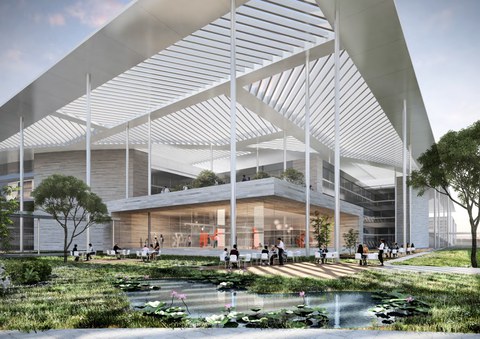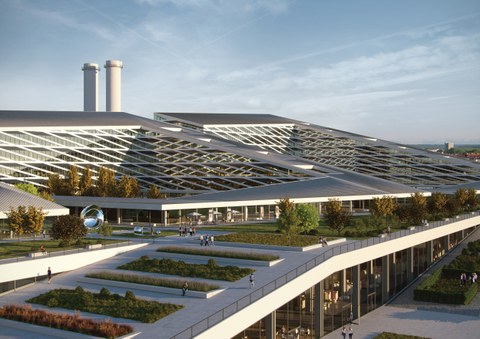LAB Living Art of Building
„Wir brauchen den Paradigmenwechsel im Bauwesen.
Nicht morgen, nicht übermorgen, jetzt.“ – Manfred Curbach
Der Zustand heute
Wir verbrauchen und übernutzen die Ressourcen unserer Erde und verändern sie massiv. Die Folgen sind Klimawandel, Ressourcenknappheit, Naturkatastrophen, Hunger, Flucht und Armut.
Das Bauwesen ist an diesen Entwicklungen massiv beteiligt. Es hatte 2018 in Deutschland einen Anteil von 5,3 % an der nominalen Bruttowertschöpfung, verursacht aber rund 25 % des CO2-Ausstoßes und verbraucht ca. 40 % der erzeugten Energie. Allein diese Diskrepanz müsste zu enormen produktiven Aktivitäten führen. Doch die Forschung erfährt eine stark unterdurchschnittliche Förderung. Angesichts dieser weiter steigenden Weltbevölkerung werden wir nicht weniger, sondern mehr bauen. Konträr dazu müssen wir den Ressourcenverbrauch und den CO2-Ausstoß radikal einschränken. Es liegt also auf der Hand, dass in Zukunft vollkommen anders gebaut werden muss, nicht nur marginal, sondern grundlegend.
Eine deutliche Intensivierung der Forschung im Baubereich gehört wegen der enormen Hebelwirkung daher national, aber auch international zu einer der wichtigsten Aufgaben mit extrem großer, gesamtgesellschaftlicher Bedeutung für die Zukunft. Es besteht akuter Handlungsbedarf.
Die Gründung eines Bundesforschungszentrums für klimaneutrales und ressourceneffizientes Bauen, genannt "LAB Living Art of Building", ist ein wichtiger Schritt, um diesen Herausforderungen erfolgreich zu begegnen. Der Haushaltsausschuss des Deutschen Bundestags hat im November 2023 deshalb beschlossen, dafür im Zeitraum 2024-2028 68,6 Mio. Euro bereitzustellen.Auf sächsischer Seite haben zudem die Landkreise Bautzen und Görlitz zugesagt, den Aufbau mit bis zu 450 Millionen Euro aus den Strukturwandelmitteln zur Verfügung zu stellen. Weitere Bundesländer, darunter z. B. Thüringen und Brandenburg, haben ihr Interesse zur Mitarbeit und Beteiligung an der Finanzierung inzwischen bekundet.
Der Blick nach vorn
Im Mittelpunkt der zukünftigen Arbeit im Bauwesen müssen die Bedürfnisse der Menschen und der Gesellschaft an die gebaute Umwelt stehen:
- nachhaltig, klimaneutral
- ressourcenschonend, recycelbar auf allen Ebenen (Bauwerke, Bauteile, Material)
- langlebig und leicht reparabel
- variabel verwendbar, veränderbar in der Nutzung
- ästhetisch, sicher und wertvoll (im Sinne von „Werte schaffend“)
- menschenwürdig (global gedacht)
- dem Menschen zugewandt, das menschliche Maß beachtend
- das Leben in allen Altersklassen berücksichtigend
Die Mission
Die Bauwerke der Zukunft werden weder mit den Materialien noch den Methoden entworfen und gebaut, wie wir sie heute kennen. Stattdessen werden sie mit Methoden der künstlichen Intelligenz geplant, konstruiert und berechnet, ressourceneffizient hergestellt, mit KI-gestützter Gebäude-Technik ausgestattet und betrieben, mit hochempfindlichen Sensoren überwacht und gesteuert sowie von einem Digital Twin begleitet. Um dies zu erreichen, brauchen wir Erkenntnisgewinn in großem Umfang – hin zu einer völlig anderen Denkweise beim Bauen als heute.
Angesichts der zunehmenden Verwendung regenerativer Energien sowie deren Speicherung können wir davon ausgehen, dass das Energieproblem mit der Zeit abnimmt, während durch die Limitierung der Materie das Problem der Ressourcenverwendung zunimmt. Da das Bauwesen einer der größten Verbraucher ist, müssen wir darauf vorbereitet sein und eine ressourceneffiziente Materialevolution in Gang setzen. In dieser Hinsicht besteht ein wichtiges Ziel darin, dass jedes Bauwerk eine möglichst lange Nutzungsdauer aufweist, einhergehend entweder mit einer langen Lebensdauer und verschiedenen Nutzungen oder auch mit mehreren Leben, bei denen beliebig große oder kleine Teile weiter-verwendet werden. Diese Wiederverwendung und -Verwertung wird auf den Skalen Bauwerk, Bauteil und Material behandelt.
Dies gilt sinngemäß auch für alle Bauwerke des Infrastrukturbaus wie z.B. Brücken, Tunnel, Straßen und Wasserbauwerke, bei denen die Nutzungsparameter z.B. durch digitale Systeme optimal bestimmt werden, um für Nutzer und Umwelt lokal und großräumig optimale Bedingungen zu schaffen (Vermeidung CO2-erzeugender Staus, variable Nutzung von Fahrspuren etc.).
Weitere Informationen: https://living-art-of-building.org/
Informationen für Journalisten:
Jost Hähnel
Tel.: 0155 660 28 209


